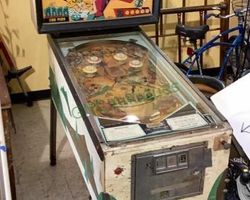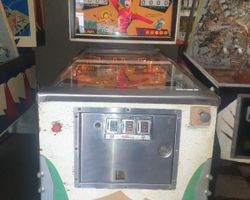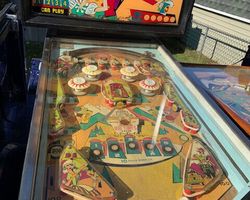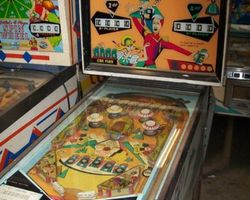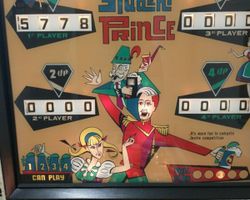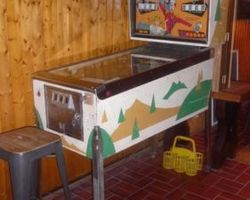Student Prince
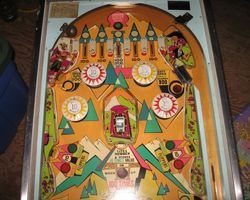
Average Prices: USD $200 to $500
Produced: June, 1968
Production Run: 3,502 units
Machine Type: Electro-mechanical
Players: 4
Design by: Steve Kordek
Art by: Christian Marche
Williams Electronics, Incorporated unveiled Student Prince in June 1968, an electro-mechanical (EM) pinball machine that drew its thematic inspiration from Sigmund Romberg's popular operetta of the same name. The operetta, based on the German play Old Heidelberg, tells a romantic story set against the backdrop of a German university town, a theme elegantly captured in the machine's artwork and playful design elements. The backglass, in particular, subtly nods to the operetta's well-known "Drinking Song," integrating the jovial atmosphere into the game's visual identity.
The creation of Student Prince was largely spearheaded by Steve Kordek, a prolific figure in pinball design, who is credited with the machine's overall design, concept, animation, and mechanical engineering. Kordek's comprehensive involvement ensured a cohesive vision from initial idea to functional machine. Christian Marche provided the artwork, his distinct style lending a period-appropriate charm that complemented the machine's operetta theme. Released on June 17, 1968, with a production run of 3,502 units, Student Prince represented a notable entry in Williams' extensive catalog of EM machines, standing out for its unique mechanical innovations in an era defined by mechanical ingenuity and direct player interaction. It was one of only four Williams titles to feature "closing flipper action," commonly known as zipper flippers, and one of only three 4-player Williams games to arrange the 2nd player score in the lower left and the 3rd player score in the upper right of the backglass, a minor but distinctive layout choice.
Signature Features and Design
Student Prince distinguishes itself primarily through its implementation of zipper flippers, a defining characteristic that sets it apart from many of its contemporaries. Instead of fixed flippers, these two flippers positioned at the bottom of the playfield are designed to physically close together when activated, effectively narrowing or even blocking the drain area between them. This unique mechanism is not merely a visual gimmick; it fundamentally alters shot dynamics and ball control, demanding precise timing and strategic activation from the player. When closed, the flippers can create new angles for ricochets or act as a temporary barrier, while opened, they provide the more traditional flipper experience. This duality adds a layer of depth and challenge not found in standard EM games.
Beyond the innovative flippers, the machine’s design incorporates a mechanical score drum directly within the playfield, a visual element that adds to the retro appeal and provides immediate, tactile feedback on scoring progress. Christian Marche's artwork throughout the cabinet and playfield is vibrant and detailed, perfectly aligning with the festive, collegiate theme of the operetta. The backglass, with its lively depiction of students carousing, features blinking lights that punctuate game events, adding a dynamic visual flourish. The overall aesthetic is one of robust charm, a blend of inviting visuals and compelling mechanical ingenuity that defines the classic EM era. The machine's soundscape, though simpler by modern standards, features clear and loud bells that provide satisfying auditory cues for points and achievements, a hallmark of EM design that enhances the sensory experience of play.
Playfield and Mechanics
The playfield of Student Prince presents a classic, yet engaging, EM layout designed to maximize ball movement and scoring opportunities, all while emphasizing the strategic use of its unique flipper mechanism. At the heart of the lower playfield are the two zipper flippers, which dominate the immediate player interaction. Above these, two slingshots flank the central area, designed to propel the ball back into play with unpredictable force. The upper playfield is populated by four pop bumpers, which provide erratic yet satisfying ball accelerations, and six rollover buttons, typically activated by the ball rolling over them, contributing to scoring or feature progression. Four standup targets are strategically placed, requiring direct hits to register points or initiate specific game events.
A notable feature is the upper right ball return gate, which can guide the ball back into a advantageous position for subsequent shots. A prominent center target on the playfield serves as a focal point for direct shots, often tied to significant scoring increments. The playfield layout is designed to promote a fluid, engaging experience. The distribution of targets and bumpers ensures that the ball is almost constantly in motion, requiring players to react quickly and adapt to its trajectory. The zipper flippers demand a different kind of ball control and shot execution, as their closed state creates a much narrower window for precise shots upfield, or conversely, a safer trap to prevent drains. Christian Marche's artwork wraps around these mechanical elements, depicting scenes and motifs from the operetta with rich color and period detail, enhancing the immersive quality. The lighting scheme on the playfield and the animated lights on the backglass dynamically respond to gameplay, creating a lively visual environment that underscores the joy of play.
Gameplay Dynamics
Student Prince offers a gameplay experience that is both accessible for casual players and challenging for those seeking to master its unique mechanics. The primary scoring system is straightforward, with points accumulated by hitting targets, rollovers, and the center target, which provides enhanced scoring opportunities. Each player can achieve a maximum displayed score of 9,999 points. However, the true depth of the game emerges through its specific objectives and the strategic implications of the zipper flippers.
A key objective in Student Prince involves clearing a sequence of numbers from 1 through 5, typically achieved by hitting specific targets or rollovers. Successfully completing this sequence awards an extra ball, a coveted reward that extends playtime and provides additional scoring potential. This progression adds a layer of anticipation and a clear goal beyond simply accumulating points. The zipper flippers are integral to both offense and defense. Players must learn when to activate them to close the gap, either to make a precise shot through a narrow opening or to temporarily block an impending drain. This dual function introduces a tactical element not present in conventional pinball machines, forcing players to anticipate ball trajectory and make split-second decisions about flipper activation. The challenge of the game is amplified by its propensity for quick drains, particularly via the outlanes. This necessitates a strategic approach that often includes skillful nudging to influence ball movement and guide it away from the perilous gutters. Successfully navigating these challenges, utilizing the zipper flippers for both offensive plays and defensive saves, and methodically clearing the number objectives defines the mastery of Student Prince.
Reception and Legacy
The reception of Student Prince within the pinball community has been largely positive, though not without specific observations regarding its play characteristics. The machine's defining feature, the zipper flippers, is frequently cited as its greatest strength, often described as providing a unique and highly enjoyable gameplay experience. Enthusiasts appreciate the novelty and the strategic depth they add, transforming what might otherwise be a more conventional EM layout into something distinct. The artwork, meticulously crafted by Christian Marche, consistently garners praise for its thematic appropriateness and vibrant execution, with particular appreciation for the detailed cabinet art and the engaging backglass with its blinking lights. Players also commend the gameplay itself, often finding it fun, challenging, and well-balanced, highlighting the effective integration of the ruleset, the playfield design, and the progressive scoring elements. The clear, loud bells also receive positive feedback, contributing to the satisfying sensory feedback inherent in EM machines. Many appreciate its place in pinball history, valuing its classic feel and the specific innovations it brought to the table.
However, Student Prince is not universally adored without reservation. Some players point to the aggressive slingshots and unforgiving outlanes as contributing to frequent and often frustrating ball drains. This aspect can make achieving high scores particularly challenging and may require considerable nudging skill to mitigate. While many find the game captivating, a minority of players find that its unique mechanics and demanding playfield do not align with their personal preferences, suggesting that the enjoyment can be highly subjective.
Despite these differing views on its difficulty, Student Prince has secured a notable legacy. As one of only a handful of Williams machines to incorporate zipper flippers, it stands as an important artifact of mechanical experimentation in the EM era. Its unique flipper mechanism, though not widely adopted across the industry, demonstrates a willingness to push boundaries in playfield design. This machine serves as a reminder of an era when designers like Steve Kordek explored novel ways to interact with the ball, making Student Prince a compelling example of innovation and an enduring favorite for those who appreciate its distinct gameplay character and historical significance.
Sponsored Links
 Ebay Listings
Ebay Listings
 Auction Results
Auction Results
| Cost | Location | Date |
|---|---|---|
| USD $220 |  Virginia, United States Virginia, United States |
08 May, 2024 |
| USD $400 |  United States United States |
07 December, 2023 |
| EUR €695 |  Hessen, Germany Hessen, Germany |
17 July, 2023 |
| EUR €585 |  Hessen, Germany Hessen, Germany |
08 July, 2023 |
| EUR €604 |  Hessen, Germany Hessen, Germany |
05 July, 2023 |
| EUR €1,590 |  Nordrhein-Westfalen, Germany Nordrhein-Westfalen, Germany |
01 May, 2021 |
| EUR €95 |  Saarland, Germany Saarland, Germany |
23 February, 2020 |
| USD $200 |  Michigan, United States Michigan, United States |
09 May, 2019 |
| EUR €700 |  Nordrhein-Westfalen, Germany Nordrhein-Westfalen, Germany |
26 March, 2019 |
| USD $525 |  Pennsylvania, United States Pennsylvania, United States |
02 February, 2019 |


Private Policy · Search Website · Contact Us
As an eBay Partner, we may earn a commission from qualifying purchases made through links on this site, at no additional cost to you.
All trademarks and copyrighted materials remain property of their respective owners. All other content copyright 2007 - 2026 Pinpedia.

